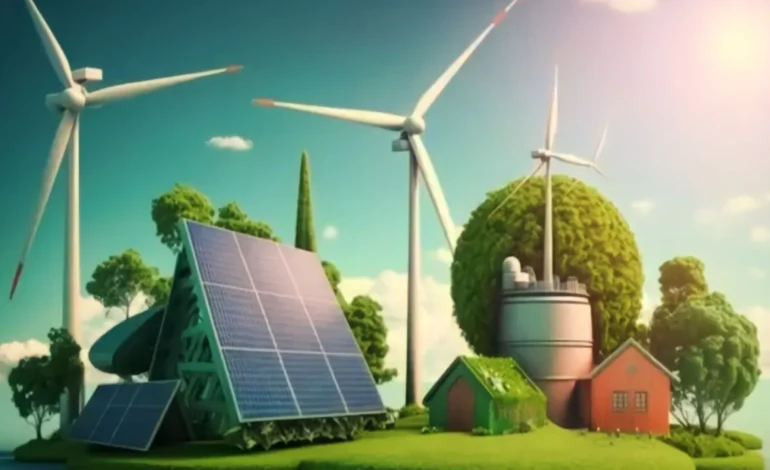
Renewable Energy Revolution: Powering the Future While Fighting Climate Change
Introduction
The world is poised to make a significant shift from fossil fuels to renewable energy sources in the face of mounting environmental concerns and the indisputable truth of climate change. This revolution—often called the “Renewable Energy Revolution“—represents a fundamental shift in how humans use nature’s power to sustain contemporary society, going beyond simple technological advancements. There is an urgent need for clean, sustainable energy sources as the effects of climate change become more apparent. This blog examines the many facets of the revolution in renewable energy, its importance in halting global warming, and the opportunities it presents.
The Urgency of Climate Change
The buildup of greenhouse gases (GHGs) in the atmosphere, such as carbon dioxide (CO2) and methane (CH4), is what causes climate change, which is a serious threat to human health, economies, and ecosystems around the world. The main cause of these emissions is the burning of fossil fuels for energy. With significant ramifications, the average global temperature has already risen by roughly 1.1°C beyond pre-industrial levels, according to the Intergovernmental Panel on Climate Change (IPCC).
- Extreme Weather Events: Some of the obvious effects of climate change include an increase in the frequency and severity of hurricanes, heat waves, droughts, and floods.
- Rising Sea Levels: As a result of sea level rise brought on by melting glaciers and polar ice, coastal ecosystems and communities are at risk.
- Biodiversity Loss: As a result of habitat disruption brought on by changing climates, species become extinct, and biodiversity declines.
- Risks to Human Health: Climate change makes air pollution, heat-related ailments, and disease transmission worse.
It is essential to switch to renewable energy sources in order to address these issues since they call for a swift decrease in GHG emissions.
Renewable Energy: The Backbone of a Sustainable Future
The use of renewable energy sources, such as biomass, geothermal, hydro, solar, and wind, is essential for lowering greenhouse gas emissions and slowing down global warming. Renewable energy sources are plentiful and sustainable, and leave less of an environmental impact than fossil fuels. Let’s examine these important energy sources in more detail:
Solar Energy
Solar energy uses solar thermal or photovoltaic (PV) cells to capture solar radiation. The affordability and efficiency of solar technologies have greatly increased in recent years.
Advantages:
- Plenty: The sun produces more energy in a single hour than the entire planet consumes in a year.
- Scalability: Solar farms and residential rooftops can both be equipped with solar systems.
- Low Maintenance: Solar panels have a long lifespan and require little upkeep.
Challenges:
- Intermittency: The production of solar power is contingent upon the weather and fluctuates throughout the day.
- Storage: To guarantee a consistent power supply, effective energy storage systems are required.
Wind Power
Wind turbines are devices that harness wind energy and transform its kinetic energy into electrical power. It’s among the renewable energy sources with the quickest rate of growth.
Benefits:
- High Efficiency: Newer wind turbines have a high-efficiency level and can produce a sizable amount of electricity.
- Dual Land Use: Dual land use is possible when wind farms and agricultural land coexist.
Difficulties:
- Intermittency: Wind energy is erratic and contingent on meteorological circumstances, much like solar energy.
- Environmental Impact: Local fauna, especially birds and bats, may be impacted by wind turbines.
Hydro Energy
Using the gravitational force of falling or flowing water, hydropower produces energy. It is a reputable and well-established renewable energy source.
Benefits:
- Consistency: Hydropower offers a reliable and steady energy supply.
- Storage: By storing water for later use, hydroelectric dam-created reservoirs can serve as a form of energy storage.
Difficulties:
- Environmental Impact: Communities may be uprooted and local ecosystems disturbed by damming rivers.
- Geographic Restrictions: The number of suitable locations for hydroelectric plants is restricted geographically.
Geothermal Energy
Geothermal energy uses heat from the Earth’s interior to produce direct heating and electricity.
Benefits:
- Dependability: Geothermal energy plants offer a consistent and dependable energy supply that is not impacted by the weather.
- Low Emissions: Compared to the use of fossil fuels, the production of geothermal energy produces fewer emissions.
Difficulties:
- Geographic Restrictions: Geothermal resources are limited to specific locations, typically those in tectonically active areas.
- Initial expenditures: Drilling and plant construction have significant up-front expenditures.
Biomass Energy
Animal and plant waste are examples of organic materials used to produce biomass energy. It can be used as fuel for vehicles, to heat buildings, and to generate electricity.
Benefits:
- Carbon Neutrality: Because the CO2 absorbed during the biomass source’s growth balances the CO2 released during combustion, biomass is regarded as carbon neutral.
- Waste Reduction: By using waste products as energy, methane emissions from landfills are decreased.
- Difficulties: Resource Management: In order to prevent deforestation and other negative environmental effects, sustainable biomass resource sourcing and management are essential.
- Emissions: Burning biomass can emit pollutants even though its emissions are typically lower than those of fossil fuels.
Technological Innovations and Integration
Continuous technological developments and advancements that improve efficiency, lower costs, and solve the intermittent nature of renewable energy sources are what are propelling the renewable energy revolution.
Solutions for Energy Storage
Batteries in particular are essential for energy storage systems in order to incorporate renewable energy sources into the grid. Lithium-ion, solid-state, and flow batteries are examples of advanced battery technologies that are extending the life, efficiency, and capacity of batteries.
- Grid Stability: By balancing supply and demand, storage technologies contribute to the stability of the energy grid.
- Off-Grid Applications: In isolated and off-the-grid areas, batteries make it possible to use renewable energy.
Smart Grids
Digital technology is incorporated into smart grids to improve the power grid’s flexibility, dependability, and efficiency.
- Demand Response: To maximize the usage of renewable energy, smart networks can modify energy use in response to supply conditions.
- Real-Time Monitoring: Data on energy production and consumption are available in real-time thanks to sophisticated sensors and communication technology.
Big Data and Artificial Intelligence
Artificial Intelligence and big data analytics are essential for optimizing renewable energy systems.
- Predictive Maintenance: By using AI algorithms to forecast equipment malfunctions and plan maintenance, downtime and expenses can be decreased.
- Energy Forecasting: By anticipating weather patterns and energy consumption, precise forecasting models enhance the integration of variable renewable energy sources.
Policy and Economic Factors
Technology alone won’t be enough to ensure a smooth transition to renewable energy; encouraging legislation and financial incentives are also essential.
Policies and Incentives of the Government
All throughout the world, governments are putting laws and incentives into place to encourage the use of renewable energy.
- Subsidies and Tax Credits: Grants, tax credits, and other financial incentives lower the upfront cost of installing renewable energy systems.
- Renewable portfolio standards (RPS): laws stipulating that a predetermined proportion of energy must originate from renewable sources.
- Carbon Pricing: To internalize the environmental cost of carbon emissions, carbon taxes or cap-and-trade schemes are put into place.
Private Sector and Investment
The market for renewable energy is significantly fueled by investment and innovation from the private sector.
- Corporate Sustainability Goals: A lot of businesses are aiming high when it comes to sustainability; one such goal is to switch to 100% renewable energy.
- Green Bonds: Financial securities intended to finance renewable energy and other environmentally friendly projects.
- Public-Private Partnerships: Governments and private businesses working together on joint projects speed up the adoption of renewable energy technologies.
Social and Environmental Benefits
Many social and environmental advantages result from the switch to renewable energy, paving the way for a more just and sustainable future.
Protection of the Environment
- Lower Emissions: Making the switch to renewable energy has a major positive impact on air pollution and greenhouse gas emissions.
- Preservation of Resources: By lowering dependency on finite fossil fuels, renewable energy preserves natural resources for upcoming generations.
Economic expansion and the creation of jobs
Green employment: From production and installation to maintenance and research, the renewable energy industry supports millions of employment globally.
Energy Independence: By reducing their reliance on imported fossil fuels, nations can increase their energy security and economic stability by investing in renewable energy.
Health Benefits
- Cleaner Air: By reducing the combustion of fossil fuels, air pollution is decreased, improving public health and lowering medical expenses.
- Less Noise Pollution: When compared to fossil fuel power plants, renewable energy technologies—particularly solar and wind—produce less noise pollution.
Obstacles and Prospects for the Future
Although there is much promise for the renewable energy revolution, there are a number of obstacles that must be overcome before it can reach its full potential.
Grid Integration and Intermittency
Because solar and wind energy are erratic, it is imperative that smart grid technologies and strong energy storage solutions be developed in order to guarantee a steady supply of electricity.
Investment and Infrastructure
To enable the broad use of renewable energy, significant infrastructure investment is needed. This includes creating storage facilities, modernizing transmission lines, and creating new renewable power plants.
Policy and Regulatory Hurdles
Policies that are supportive and consistent are essential to the expansion of the renewable energy industry. To promote long-term commitments to renewable energy, policymakers must remove regulatory obstacles and provide a stable investment climate.
Public Knowledge and Acknowledgment
Renewable energy projects must be successful in order for the public to be aware of and accept them. Misconceptions can be cleared up and the advantages of renewable energy can be emphasized through education and community involvement.
Conclusion
A key element of the international effort to tackle climate change and create a sustainable future is the revolution in renewable energy. Humanity can lessen its carbon footprint, save the ecosystem, and build a more resilient and just society by using the power of the sun, wind, water, and the Earth itself. Even though there are still obstacles, the continuous technological developments, encouraging laws, and rising public and private sector commitments offer a strong basis for renewable energy’s sustained expansion. It is imperative that we embrace the renewable energy revolution as we proceed since it is essential to the health of our planet and future generations.





